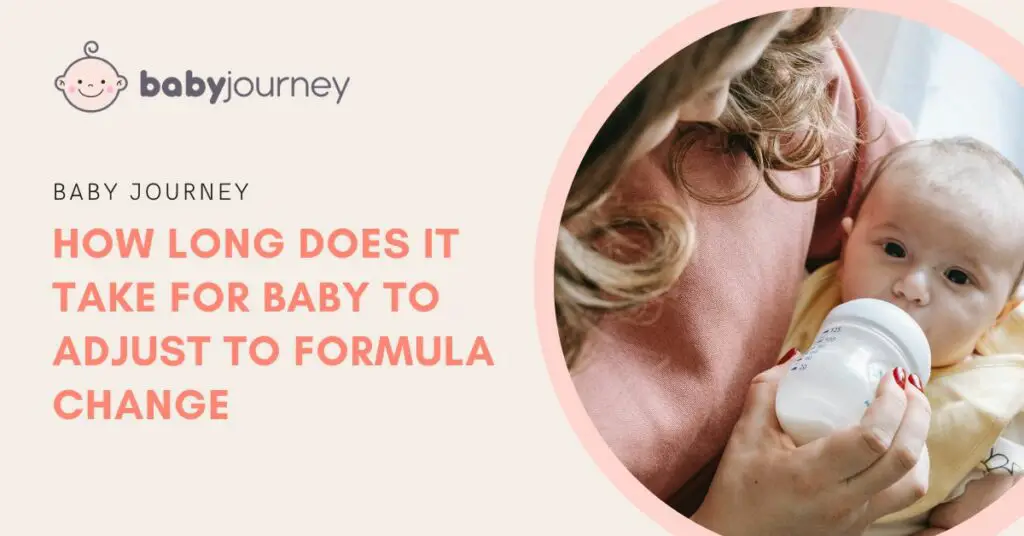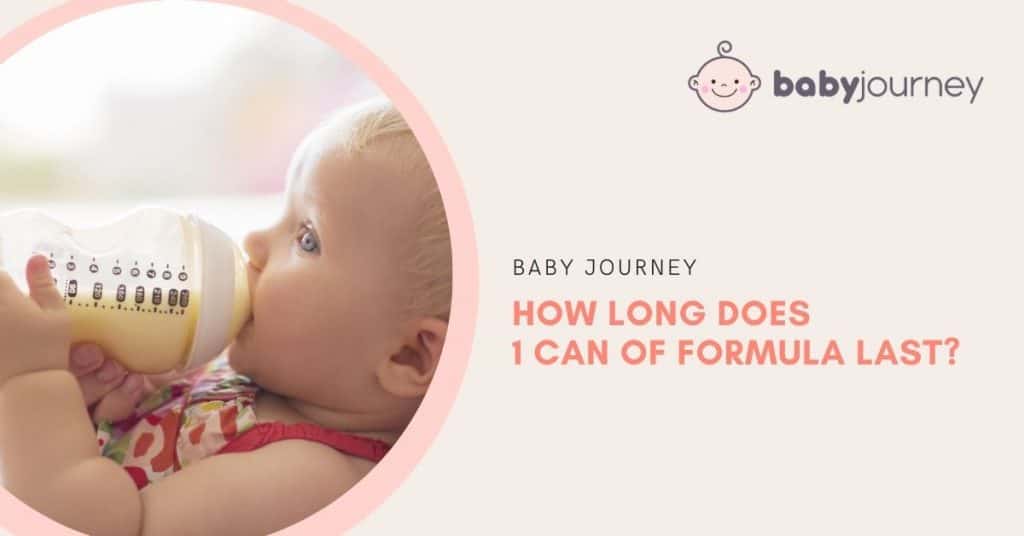When it comes to feeding a baby, choosing the right formula can be a daunting task for new parents. Not all formulas are created equal, and what works for one baby may not work for another. Even if you find the right formula for your baby, there may come a time when you need to switch to a different one. But how long does it take for a baby to adjust to a formula change?
According to research, it can take up to 10 days for a baby to adjust to a new formula. During this time, parents should monitor their baby carefully for any signs of discomfort or negative side effects. While some babies may adjust to a new formula quickly, others may take longer, and it’s important to be patient and give your baby time to adapt.
It’s also worth noting that switching from breastmilk to formula can be a gradual process. Parents should start by introducing small amounts of formula and gradually increasing the amount over time. This can help the baby adjust to the new formula more easily and reduce the risk of digestive upset. Overall, it’s important to consult with a pediatrician before making any changes to your baby’s diet and to be patient during the adjustment period.
Understanding Baby Formula

Baby formula, also known as infant formula, is a milk-based or soy-based substitute for breast milk. It is designed to provide the necessary nutrition for infants who are not breastfed or who require supplementation.
There are various types of baby formulas available in the market, including milk-based, soy formula, and hypoallergenic formula. Milk-based formulas are the most common and are made from cow’s milk that has been modified to resemble breast milk. Soy-based formulas, on the other hand, are made from soy protein and are an option for infants who are allergic to cow’s milk. Hypoallergenic formulas are designed for infants with allergies or sensitivities to cow’s milk protein and contain proteins that are broken down into smaller pieces.
Some popular brands of baby formula include Enfamil, Similac, and specialized formulas like Enfamil Enspire Infant Formula. These formulas are available in ready-to-feed or powdered form, and parents can choose the one that best suits their baby’s needs.
When preparing baby formula, it is important to follow the instructions on the packaging carefully. Improperly prepared formula can lead to digestive issues, such as constipation or diarrhea. Parents should also ensure that the formula is stored correctly and used before its expiration date.
In conclusion, baby formula is a safe and effective alternative to breast milk for infants who are not breastfed or who require supplementation. There are various types of baby formulas available, and parents should choose the one that best suits their baby’s needs. It is important to prepare and store the formula correctly to ensure that the baby receives the necessary nutrition.
Transitioning to Formula

Transitioning from breastmilk to formula can be a challenging process for both parents and babies. It is important to approach the transition gradually to allow for adjustment and to minimize discomfort for the baby.
When transitioning to formula, it is recommended to introduce it slowly, starting with a small amount and gradually increasing it over time. This allows the baby’s digestive system to adjust to the new formula. It is also important to choose a formula that is appropriate for the baby’s age and needs.
Parents should consider paced feeding techniques to help the baby adjust to the new feeding method. This involves holding the baby in a more upright position and allowing them to control the flow of the formula. This can help prevent overfeeding and reduce the risk of digestive discomfort.
If the baby is already bottle-fed, it is important to ensure that the bottle and nipple are appropriate for the baby’s age and feeding needs. Parents should also follow proper preparation techniques for the formula to ensure that it is safe and nutritious for the baby.
Partial weaning may also be an option for some parents who want to gradually transition from breastfeeding to formula. This involves gradually reducing the number of breastfeeding sessions and replacing them with formula feedings.
Parents who are returning to work may need to consider expressing breast milk and storing it for later use. This can help maintain the baby’s feeding routine and provide them with the benefits of breast milk even when the parent is not present.
Overall, transitioning to formula requires patience and a gradual approach. With proper preparation and techniques, parents can help their baby adjust to the new feeding method and ensure that they are getting the nutrition they need to grow and develop.
Potential Challenges and Symptoms

When switching to a new formula, babies may experience a range of symptoms as their digestive system adjusts. Some common symptoms include gas, constipation, diarrhea, and fussiness. In some cases, babies may also experience vomiting, rashes, hives, or allergic reactions.
Gas is a common issue that can cause discomfort for babies. It can be caused by a variety of factors, including swallowing air while feeding, a change in formula, or an intolerance to lactose. Parents can help alleviate gas by burping their baby frequently during feedings and ensuring that the baby is positioned properly while feeding.
Vomiting is another potential symptom that can occur when switching formulas. This can be caused by a variety of factors, including an intolerance to a particular ingredient in the formula or an allergic reaction. If a baby is experiencing frequent vomiting, it is important to consult with a healthcare provider to rule out any underlying medical conditions.
Allergies to formula can cause a range of symptoms, including rashes, hives, and gastrointestinal issues such as diarrhea and upset stomach. If a baby experiences any of these symptoms after switching to a new formula, it is important to speak with a healthcare provider to determine if an allergy is the cause.
Constipation is another potential issue that can occur when switching formulas. This can be caused by a variety of factors, including a change in the baby’s diet or an intolerance to a particular ingredient in the formula. Parents can help alleviate constipation by ensuring that their baby is getting enough fluids and fiber in their diet.
Fussiness and crying can also be common when switching formulas. This is often due to discomfort or digestive issues caused by the new formula. It is important for parents to be patient and provide comfort to their baby during this transition period.
In conclusion, switching to a new formula can be a challenging process for babies and parents alike. By being aware of potential symptoms and taking steps to alleviate discomfort, parents can help ensure a smooth transition for their little one. If parents have any concerns about their baby’s symptoms or overall health, they should consult with a healthcare provider.
Recognizing and Addressing Digestive Issues
When a baby is switched to a new formula, it can take up to 1-2 weeks for them to fully adjust. During this transition period, it is common for babies to experience some digestive issues. It is important for parents to recognize and address these issues to ensure their baby’s comfort and health.
One common issue is lactose sensitivity or intolerance. Lactose is a sugar found in milk, and some babies may have difficulty digesting it. Symptoms of lactose sensitivity or intolerance include diarrhea, bloating, and gas. If a baby is experiencing these symptoms, parents can try switching to a lactose-free or low-lactose formula.
Another possible issue is soy protein intolerance. Soy-based formulas are often used as an alternative to cow’s milk-based formulas, but some babies may be allergic or sensitive to soy protein. Symptoms of soy protein intolerance include diarrhea, vomiting, and skin rashes. If a baby is experiencing these symptoms, parents can try switching to a different type of formula, such as a hypoallergenic formula.
It is also important to monitor a baby’s bowel movements during the transition period. It may take a few days for a baby’s bowel movements to adjust to the new formula. However, if a baby is experiencing constipation or diarrhea, this may be a sign of a digestive issue. Parents should consult with their pediatrician if their baby’s bowel movements are abnormal or if they have concerns about their baby’s digestive health.
In some cases, a baby may have a more serious condition such as galactosemia, which is a rare genetic disorder that affects the body’s ability to process galactose, a sugar found in milk. If a baby is diagnosed with galactosemia, they will need to avoid all milk-based products and be given a special formula.
Overall, it is important for parents to be aware of potential digestive issues when switching their baby to a new formula. By recognizing and addressing these issues, parents can ensure their baby’s comfort and health during the transition period.
Consulting with a Pediatrician
When it comes to switching your baby’s formula, it’s always a good idea to consult with a pediatrician. They can provide you with valuable advice and guidance on the best course of action for your baby’s health.
Pediatricians can help you determine if your baby needs to switch formulas or if there are other underlying issues that need to be addressed. They can also recommend specific formulas that may be better suited for your baby’s needs.
In some cases, a pediatrician may prescribe medication to help alleviate any discomfort or issues your baby may be experiencing. It’s important to follow their instructions carefully and to ask any questions you may have about the medication.
Overall, consulting with a pediatrician can provide you with peace of mind and help ensure that your baby is getting the best possible care. If you have any concerns or questions about your baby’s formula or health, don’t hesitate to reach out to a trusted pediatrician for guidance.
Benefits of Different Types of Formula

When it comes to choosing the right formula for your baby, there are many options available. Each type of formula has its own unique benefits that may be more suitable for your baby’s needs. Here are some benefits of different types of formula:
Cow’s Milk-Based Formula
Cow’s milk-based formula is the most commonly used formula and is suitable for most babies. It is made from cow’s milk that has been modified to resemble breast milk. This type of formula is usually less expensive than other types, making it a popular choice for many parents. It also contains DHA and lutein, which are important for brain and eye development.
Soy-Based Formula
Soy-based formula is a good option for babies who are allergic to cow’s milk or have trouble digesting lactose. It is made from soy protein and does not contain lactose. Soy-based formula is also a good choice for vegan families who do not want to use animal products. However, it is important to note that soy-based formula may not be suitable for babies with thyroid problems.
Hydrolyzed Formula
Hydrolyzed formula is a type of formula that is broken down into smaller proteins, making it easier for babies to digest. This type of formula is a good option for babies with allergies or intolerances to cow’s milk or soy-based formula. It is also a good choice for babies with low milk supply or who are not nursing.
Specialty Formula
There are also specialty formulas available for babies with specific needs. For example, there are formulas designed for premature babies, babies with reflux, and babies with colic. These formulas are usually more expensive than other types of formula, but they may be necessary for some babies.
In conclusion, choosing the right formula for your baby can be a difficult decision. It is important to consider your baby’s needs and preferences when selecting a formula. Cow’s milk-based formula is the most commonly used formula and is suitable for most babies. Soy-based formula is a good option for babies who are allergic to cow’s milk or have trouble digesting lactose. Hydrolyzed formula is a good option for babies with allergies or intolerances to cow’s milk or soy-based formula. Specialty formulas are available for babies with specific needs.
Adjusting to New Formula

When switching to a new formula, it is important to be patient as it can take time for a baby to adjust. According to experts, it typically takes around 7 to 10 days for a baby to adjust to a new formula. However, some babies may need more time to get used to the new taste and texture.
There are several reasons why parents may decide to switch formula. Some babies may experience discomfort, such as gas or fussiness, while others may have an allergy or intolerance to certain ingredients. It is important to consult with a pediatrician before making any changes to your baby’s diet.
Different types of formula are available on the market, including cow’s milk-based, soy-based, and hypoallergenic formula. Each type has its own benefits and drawbacks, and it is essential to choose the right one for your baby’s needs.
When switching formula, it is recommended to introduce the new formula gradually. Start by mixing a small amount of the new formula with the old formula and gradually increase the amount over several days. This can help prevent any sudden changes that may upset the baby’s digestive system.
It is also important to monitor your baby’s reaction to the new formula. Some babies may experience side effects such as diarrhea, constipation, or vomiting. If you notice any unusual symptoms, consult with your pediatrician immediately.
In summary, adjusting to a new formula can take time, and it is essential to be patient and monitor your baby’s reaction. Consult with a pediatrician before making any changes to your baby’s diet and introduce the new formula gradually.
Conclusion
Adjusting to a new formula can be a challenging process for babies and parents. However, with patience and careful observation, it is possible to make the transition as smooth as possible.
It is important to remember that every baby is different, and some may adjust faster or slower than others. Generally, it takes around 7 to 10 days for a baby to adjust to a new formula. During this time, parents should monitor their baby’s behavior and look out for any signs of discomfort or digestive issues.
When switching formulas, parents should consult with their pediatrician to ensure that the new formula is appropriate for their baby’s age and nutritional needs. It is also important to follow the instructions on the formula packaging carefully and prepare it safely to avoid any risk of contamination.
Parents can also try different techniques to help their baby adjust to a new formula, such as gradually introducing the new formula or mixing it with the old formula. Additionally, adding breast milk to the bottle can help ease the transition for breastfed babies.
Overall, adjusting to a new formula can be a process that requires patience and careful observation. By taking the necessary precautions and consulting with a pediatrician, parents can help their baby make a smooth transition to a new formula.
Frequently Asked Questions
How long does it take for a baby’s body to get used to formula?
It typically takes a baby around 7 to 10 days to adjust to a new formula. During this time, parents may notice changes in their baby’s bowel movements, appetite, and overall behavior. It’s important to give the baby time to adjust to the new formula before making any further changes.
What to expect after switching to formula?
After switching to formula, parents may notice changes in their baby’s bowel movements, appetite, and overall behavior. It’s not uncommon for babies to experience some gas, constipation, or diarrhea during this transition period. However, if these symptoms persist or worsen, parents should consult with their pediatrician.
Can switching between breastmilk and formula upset stomach?
Switching between breastmilk and formula can sometimes cause stomach upset in babies. This is because breastmilk and formula have different compositions, and a sudden change in diet can be difficult for a baby’s digestive system to handle. If parents need to switch between breastmilk and formula, it’s best to do so gradually over a period of several weeks.
When to switch formula because of gas?
If a baby is experiencing excessive gas or discomfort after feedings, it may be time to switch formula. Parents should consult with their pediatrician to determine the best course of action. In some cases, a different type of formula may be recommended to address the baby’s specific needs.
Will changing formula affect my baby?
Changing formula can sometimes affect a baby’s digestion and behavior. It’s important to introduce new formula gradually and monitor the baby’s response. If parents notice any significant changes in their baby’s behavior or health, they should consult with their pediatrician.
How do I know if formula isn’t agreeing with baby?
If a baby is experiencing excessive gas, constipation, diarrhea, or other digestive issues, it may be a sign that the formula isn’t agreeing with them. Parents should consult with their pediatrician to determine the best course of action. In some cases, a different type of formula may be recommended to address the baby’s specific needs.




